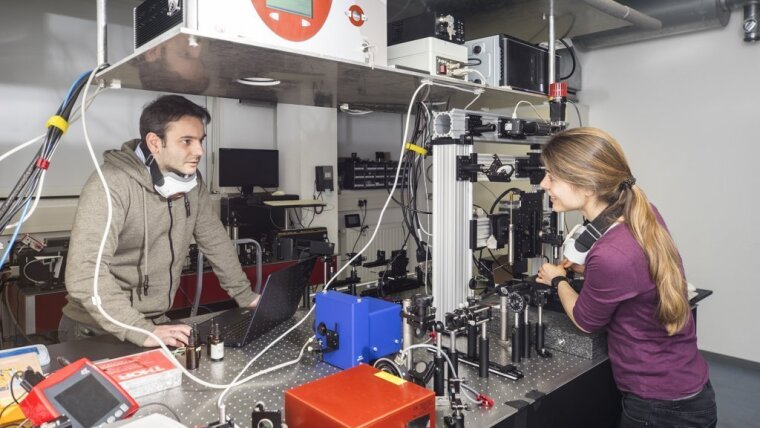
- Light
- Forschung
Published: | By: Ira Winkler
Dr Alessandro Alberucci has been working in the Ultrafast Optics working group since 2017 - specifically in the fields of nonlinear optics, femtosecond-written waveguides and geometric phase.
The journal "Optical Materials ExpresExternal links" has just (04.03.2024) reported that a research group led by Dr. Alberucci and Prof. Nolte has developed a new way of modulating optical signals in a laser-written waveguides in glass by inserting a liquid crystal layer.
How exactly can we understand this liquid crystal layer?
Liquid crystals are probably the most important material in applications when an electric control of light propagation is required, see for example the display technology. Essentially, the application of an electric field induces the rotation of the molecules, the effect being strong due to the liquid nature of the material. Then the crystal side becomes relevant: in a crystal the optical propagation depends on the direction of the lattice. Thus, the rotation of the liquid crystal molecules yields a change in the optical properties, thus allowing a very efficient electro-optical modulation.
Our basic idea is quite simple: we took a standard liquid crystal cell, composed of two glass slides with the liquid crystal placed in the middle. We then applied our prior knowledge on writing waveguides in glass by focusing ultrashort intense pulses.
What previous problems can it solve and which applications benefit from it in particular?
Laser-written waveguides are a very interesting technology for integrated optics, allowing a full three-dimensional control on the waveguide position and topology. Nonetheless, a great limitation is the lack of an efficient way to modulate the signal. Other groups demonstrated modulators based on the thermo-optical effect, but this approach is intrinsically limited to the surface of the sample. Beyond other advantages such as a lower power consumption, our method can potentially lead to modulators distributed inside the whole volume of the sample, thus fully exploiting the 3D nature of the technology.
Can you please briefly describe who exactly worked with you on this technology, how long have you been on the trail of the problem and what barriers have been overcome?
Dr. Lammers conducted all the experimental work, including the writing of the waveguides and the testing of their response. Together with Dr. Chandroth Pannian I took care of the theoretical model. Prof Szameit from the University in Rostock and Prof. Nolte conceived the original idea of using liquid crystals to modulate the signal few years ago, but initial attempts failed due to problems with the alignment of the liquid crystal in laser-written structures. To overcome this hurdle, I then proposed to use a commercial cell, where such problems are absent, even though the writing of waveguides on them is harder.
What are the next goals?
There are several paths to follow. The lowest branch is to investigate nonlinear modulation, that is, when the optical beam is directly rotating the molecules. From a more applicative point of view, the next step is to write an array of waveguides and check the effect of the modulation on them. In a longer perspective, the idea is to shape the electrodes of the cell so as to achieve an independent control on each of the waveguide written in the glass.